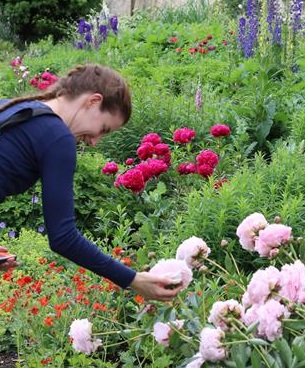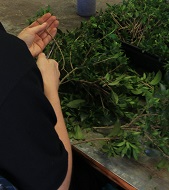Sneak Peak
Know What Plant Will Work Where
Expanded and Revised Recently
Learn how to choose the right plants for various situations. The Planting What Where Short Course is ideal for home gardeners or beginners in the garden design industry and provides a complete learning experience with practical exercises that you can do at home.
This self-guided study program provides learners with the opportunity to understand about plant selection in a short course setting. Using a self-paced, interactive study guide; you can take as much or little time as you wish to complete this course.
As you progress through each lesson; you will be provided with a range of ways you can expand your learning. By choosing what tasks you do and don't undertake; you can expand in areas that interest you most and skip areas of less interest.
At the end of each lesson, you will be given a short interactive test to undertake, which will provide an indication of how your learning is progressing. Upon completing the very last lesson, you will be offered a more thorough automated test or examination. This final assessment can be undertaken at any time of day or night; and any day of the week. If you achieve an overall pass, you will be able to obtain a "Certificate of Completion".
Course Content
There are 13 lessons in this course:
 LESSON 1 PLANT SELECTION
LESSON 1 PLANT SELECTION
- Introduction - criteria for plant use
- Planting strategies
- Inspecting plants before purchase
- Know your plants -Annuals
LESSON 2 PLANT ESTABLISHMENT METHODS
- Ways to help plants get established
- Trickle irrigation
- Mulches
- Tree guards
- Techniques for planting sloped areas -pocket
- planting, slope serration, wattling
- Planting arid sites -direct seeding, spray seeding
- Rehabilitating damaged soils in the home garden
- What can go wrong
- Improving soil in a new garden
- Lime loving plants
- Fertilisers
- Salinity, pH, etc
- Problems with dogs and cats
- Know your plants - Fruit trees
LESSON 3 DETECTING PROBLEMS
- Pests
- Diseases
- First: conduct an inspection
- Second: take note of the environment
- Third: identify the problem
- Fourth: treat the problem
- Review what you have been learning
- Solutions for wet areas
- What can cause wet areas in your garden?
- Problems with wet areas
- Overcoming problems with boggy or wet areas
- Know your plants - orchids
LESSON 4 PLANTS FOR WET/ BOGGY SITES
- How to keep the soil wet all year
- Plants that grow in permanently wet soil
- Plants that tolerate wet in winter and drier soil in summer
- Creating a bog garden
- Construction of water gardens
- Plants for water gardens
- Review what you have been learning
- Gardening in the Shade
- Ferns

LESSON 5 SHADE
- Considering shade problems
- Plants suited to full shade
- Ferns for varied levels of shade
- Shade trees
- Where to plant the shade tree
- Deciduous or semi deciduous trees
- Evergreen shade trees
- Know your plants - perennials
LESSON 6 WINDBREAKS HEDGES AND SCREENS
- Why use screening plants
- Hedges
- Hedge plants for different situations
- Windbreaks
- Know your plants - ornamental trees
LESSON 7 PLANTS FOR DRY GARDENS
- Introduction
- Gardening in dry conditions
- Overcoming dryness
- Dry pots
- Growing dry loving plants in moist soil
- Selecting drought tolerant trees
- Drought tolerant trees for various situations
- Design and planting a fire break
- How to arrange plants
- Distances from buildings
- Considerations - winds, vehicular access, fire resistant plants
- Fire resistant plants
- Know your plants -succulents
LESSON 8 COASTAL GARDENS
- Dealing with salt
- Creating wind breaks
- Hardy seaside plants
- Know your plants - palms
LESSON 9 TREES AND SHRUBS
- Evergreen trees
- Cool conifers
- Deciduous trees for autumn colour
- Shrubs in the landscape
- Examples of long flowering plants
- Shrubs that flower in autumn
- What flowers in winter
- Living Christmas trees
- Know your plants - shrubs
LESSON 10 FITTING MORE IN A SMALL GARDEN
- How to fit more in a small garden
- Small trouble free plants
- Space-saving decoration
- Go up
- Expand your garden
- Colours
- Design your garden to appear bigger
- Know your plants -climbers
LESSON 11 PLANTS FOR VARIOUS SITUATIONS
- Frost hardy plants
- Hardy plants for inner city gardens
- Plants for pets
- Long narrow areas
- Know your plants - indoor plants
LESSON 12 LAWNS
- Choosing the right lawn
- Turf varieties
- Lawn mixes
- What turf to grow where
- Know your plants - grasses and grass like plants
LESSON 13 LIVING GARDEN ART
- Living art
- How to make a hedge
- Miniature/table top gardens
- Using junk in living gardens
- Know your plants - bulbs and rhizomes
Expanded and Revised
We cross referenced this course with all of the plants regularly being sold in a series of retail garden centres to determine plants you need to know about; and based on what we identified; extra information was added to each of the lessons. This course is covers an exceptional range of plants and how to use them. You will find more plants covered in this course than what are covered by courses elsewhere.
Who is this Course For?
This course can be equally valuable to both amateurs or professionals. Good knowledge of what plants to grow where is rare today. Many people just don't understand the implications of making poor choices about the plants they use. Professional engineers, architects, planners, developers, and sometimes even landscape professionals, are often found to be planting species that will eventually damage pipes, foundations or pavement; cause allergic reactions to people living around them, or simply not grow well and die young. These and other problems are common in urban and rural locations; residential, commercial and industrial areas.
This course can set you on the path to a far greater awareness about plants and plant selection.
It can be of great value to:
- Amateur gardeners
- Professional horticulturists, nursery workers, gardeners
- Farmers and land managers
- Developers, engineers, architects and planners
- Anyone else who works with plants
How does this course work?
You can enrol at any time
Once you have paid for the course, you will be able to start straight away.
Study when and where you like. Work through at your own pace.
You can download your study-guide to your smart phone, tablet or laptop to read offline.
There are automated self-assessment tests you can complete at the end of each lesson. You can attempt these as many times as you wish and each time, upon completion, you can see your results. You will need internet access to complete the self assessment tests.
At the end of the course, you are presented with a large assessment which can be attempted online, anywhere, anytime. If you achieve a 60% pass in the exam; you immediately receive a downloadable certificate of completion with your name on it. If you do not achieve a 60% pass rate, you can contact us to re-sit your exam. ( email- admin@acs.edu.au )
Contact us at anytime if you have any issues with the course. admin@acs.edu.au
SEE A LARGE RANGE OF PLANT EBOOKS WRITTEN BY OUR STAFF
UP TO DATE RESOURCES AVAILABLE AT www.acsebooks.com for reliable advice on what to plant where.